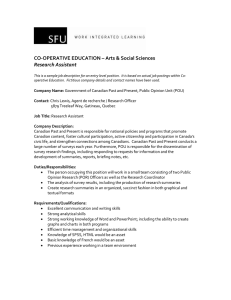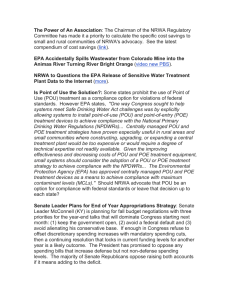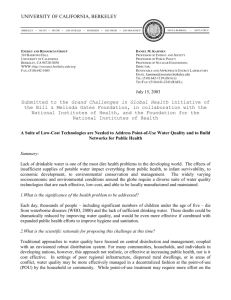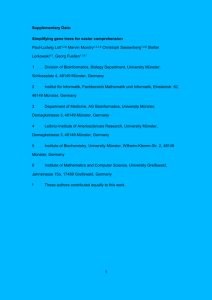Good Samaritans or Mercy Killers: And Never the ‘Twain Shall... By Frank W. Dawkins, J.D., LL.M. candidate
advertisement
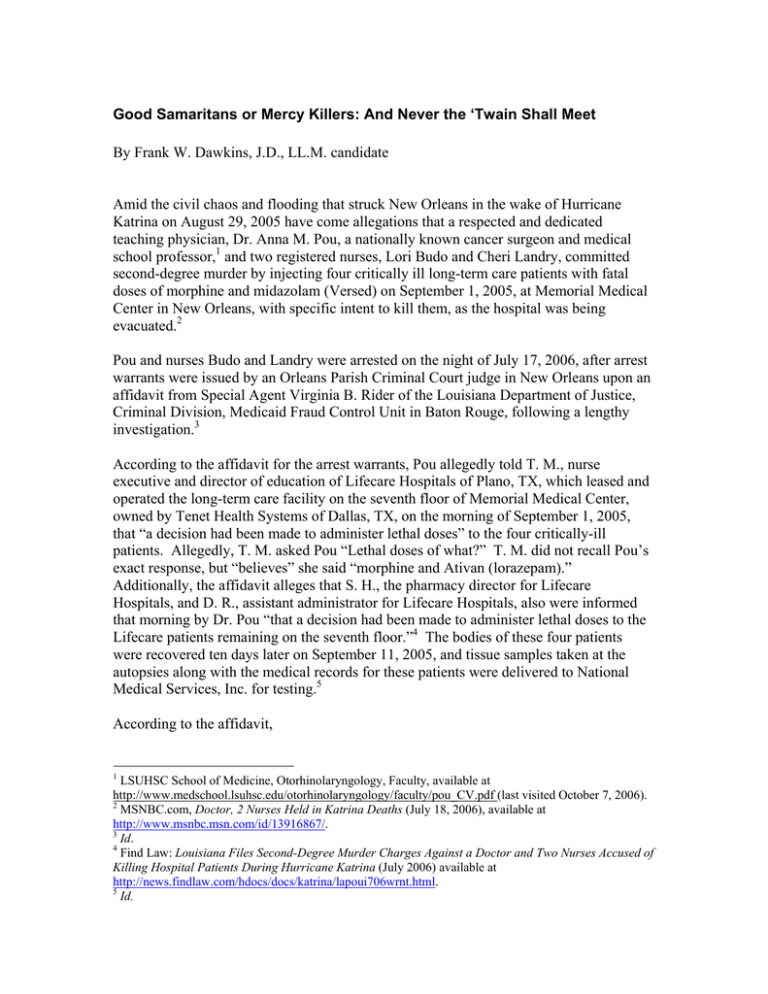
Good Samaritans or Mercy Killers: And Never the ‘Twain Shall Meet By Frank W. Dawkins, J.D., LL.M. candidate Amid the civil chaos and flooding that struck New Orleans in the wake of Hurricane Katrina on August 29, 2005 have come allegations that a respected and dedicated teaching physician, Dr. Anna M. Pou, a nationally known cancer surgeon and medical school professor,1 and two registered nurses, Lori Budo and Cheri Landry, committed second-degree murder by injecting four critically ill long-term care patients with fatal doses of morphine and midazolam (Versed) on September 1, 2005, at Memorial Medical Center in New Orleans, with specific intent to kill them, as the hospital was being evacuated.2 Pou and nurses Budo and Landry were arrested on the night of July 17, 2006, after arrest warrants were issued by an Orleans Parish Criminal Court judge in New Orleans upon an affidavit from Special Agent Virginia B. Rider of the Louisiana Department of Justice, Criminal Division, Medicaid Fraud Control Unit in Baton Rouge, following a lengthy investigation.3 According to the affidavit for the arrest warrants, Pou allegedly told T. M., nurse executive and director of education of Lifecare Hospitals of Plano, TX, which leased and operated the long-term care facility on the seventh floor of Memorial Medical Center, owned by Tenet Health Systems of Dallas, TX, on the morning of September 1, 2005, that “a decision had been made to administer lethal doses” to the four critically-ill patients. Allegedly, T. M. asked Pou “Lethal doses of what?” T. M. did not recall Pou’s exact response, but “believes” she said “morphine and Ativan (lorazepam).” Additionally, the affidavit alleges that S. H., the pharmacy director for Lifecare Hospitals, and D. R., assistant administrator for Lifecare Hospitals, also were informed that morning by Dr. Pou “that a decision had been made to administer lethal doses to the Lifecare patients remaining on the seventh floor.”4 The bodies of these four patients were recovered ten days later on September 11, 2005, and tissue samples taken at the autopsies along with the medical records for these patients were delivered to National Medical Services, Inc. for testing.5 According to the affidavit, 1 LSUHSC School of Medicine, Otorhinolaryngology, Faculty, available at http://www.medschool.lsuhsc.edu/otorhinolaryngology/faculty/pou_CV.pdf (last visited October 7, 2006). 2 MSNBC.com, Doctor, 2 Nurses Held in Katrina Deaths (July 18, 2006), available at http://www.msnbc.msn.com/id/13916867/. 3 Id. 4 Find Law: Louisiana Files Second-Degree Murder Charges Against a Doctor and Two Nurses Accused of Killing Hospital Patients During Hurricane Katrina (July 2006) available at http://news.findlaw.com/hdocs/docs/katrina/lapoui706wrnt.html. 5 Id. (a)fter the [unidentified] forensic pathologist reviewed the records and the test results, he advised that in all four cases it appeared that a lethal amount of morphine was administered. Additionally, in two cases the concentration of midazolam was greater than expected from normal therapeutic doses. The forensic pathologist advised that according to the medical records, none of the four patients were being administered morphine or midazolam for their routine pharmaceutical care requirements.”6 Apparently, no trace of Ativan was found in any of the tissue samples. Dr. Pou was “on call” at Memorial Medical Center when Hurricane Katrina struck. She chose to go in because she felt she would be needed. The seventh-floor patients of Lifecare were not her patients, but their doctor did not show up. So she was acting as a volunteer to these patients.7 It is not disputed that Dr. Pou and nurses Budo and Landry gave the Lifecare patients injections of morphine and Versed. What is very much disputed is whether they intended to kill these patients. Did they merely intend to sedate the patients and ease their pain until perhaps someone would rescue them, or, because of the horrific conditions with no electricity, running water, relentless heat, humidity, stench and dwindling supplies of food, water and medications, did they believe there was no hope for these patients’ rescue or survival and so euthanized them?8 In a “60 Minutes” interview on September 24, 2006, Dr. Pou very emotionally and forcefully defended her and the nurses’ actions, saying “I want everybody to know that I am not a murderer, that we are not murderers.” She stated in the interview that her experience as a doctor working with cancer patients was her life’s focus, and said “I give hope to my patients. I am hope.” While not discussing the details of what took place on September 1, 2005, when asked by correspondent Morley Safer if she murdered those patients, Dr. Pou emphatically responded “(n)o, I did not murder those patients. I do not believe in euthanasia. But I do believe in comfort care, so they do not suffer pain.”9 In the same interview, Louisiana Attorney General Charles Foti stated “when you use both of them (morphine and Versed) together it becomes a lethal cocktail and guarantees they’re going to die.”10 But does it? Rob Middleburg, a Pennsylvania toxicology expert who is the unidentified forensic expert who examined the tissue samples taken from the four bodies, in an interview with James Varney of the New Orleans Times-Picayune, stated that “the 6 Id. 60 Minutes (CBS television broadcast Sept. 24, 2006). 8 James Varney, Doctor’s Drug Mix Not Ideal Killer (August 6, 2006), available at http://www.nola.com/printer.ssf?/base/news-6/1154844156102520.xml&coll=1. 9 See 60 Minutes, supra note 8. 10 Id. 7 presence of Versed is a red flag in post-mortem examinations. Whenever you find it out of the blue, we always raise our eyebrows a little bit. Versed is typically used with a surgery, it’s used almost exclusively in relation to general anesthesia, and you don’t find it used very often day to day for therapeutic circumstances.”11 Other experts interviewed by Varney disagreed with Middleburg, including Dr. Arthur Ackerman, a retired anesthesiologist from Princeton, NJ. Ackerman said that “Versed was not limited to surgical applications with a patient under anesthesia, and that its presence should not invite a presumption of foul play.” Dr. Steven Miles of the Minnesota Medical School’s Center for Bioethics, opined that “other drugs would be more likely and efficient candidates for euthanasia, such as potassium chloride, longacting muscle paralytics or Phenobarbital,” as compared to morphine and Versed. Dr. Miles also indicated that “the clinical differences between Versed and Ativan are not so pronounced as to provoke suspicions of criminal intent. Both sets of drugs are commonly used and used about equally in the palliative care of dying patients.”12 While the affidavit indicates that only morphine and Versed were detected in the tissue samples from the four bodies13, the results of the forensic pathology examination have not been released publicly, so the concentrations of these drugs is not yet known.14 Dr. Daniel Nuss, Pou’s department chairman at the LSU School of Medicine in New Orleans, is leading a defense fund effort for Pou and the nurses. He said that “the morphine and Versed that investigators found in the patients’ bodies are commonly given to relieve suffering and anxiety.”15 Dr. Ben deBoisblanc, who was director of critical care at Charity Hospital in New Orleans, which has remained closed since Katrina, said “if you didn’t find sedatives and analgesics in these people, I would think that was inhumane. The very fact that you found these drugs means nothing.”16 In an interview conducted for this article, Dr. Amir Halevy, formerly Director of Internal Medicine Resident Training at Baylor College of Medicine in Houston, Texas from 20002006, said that “both these drugs [Versed and morphine] are used all the time for conscious sedation and pain control in severely ill patients.” He added that dehydration could have intensified the effect of the drugs given to these patients at Memorial Medical Center in New Orleans, and that other readily available drugs such as potassium chloride, for which there is no assay to test for, would have been a much more effective drug to use if there was any intent to kill these patients. “I find it difficult to believe they intended to kill these patients because there were too many people involved,” said Dr. Halevy.17 Following Dr. Pou’s interview on “60 Minutes”, the 6,116-member Louisiana State Medical Society issued a press release on September 27, 2006, through its president, Dr. Floyd A. Buras, stating that the LSMS “is confident that Dr. Pou performed courageously 11 See Varney, supra note 9. Id. 13 See FindLaw, supra note 4. 14 See Varney, supra note 9. 15 Michelle Roberts, Doctors Lash Out at Murder Charges, THE ADVOCATE, July 27, 2006, at B3. 16 Id. 17 Interview with Amir Halevy, M. D., in Houston, Tex. (October 25, 2006). 12 under the most challenging and horrific conditions and made decisions in the best interests of her patients. … Her long and distinguished career as a talented surgeon and dedicated educator should not be tarnished as a result of these accusations.”18 Twentyfive physician members of the Baton Rouge Ear, Nose & Throat Society took out a full page ad in the July 27, 2006 edition of The Advocate boldly addressed “To The People of Louisiana,” commending Dr. Pou’s career-long dedication to her patients suffering from head and neck cancer and stating “Dr. Pou is a true patient advocate, teacher, and friend. Her compassion is unmatched. Her dedication is unequaled. Following her arrest, her first concern was only for her patients. We hold Dr. Anna Pou in the highest regard both professionally and ethically.”19 The American Medical Association’s press release was more cautious, stating “(t)he facts of this case appear complex, remain under investigation, and based on media reports, are sharply contested. Dr. Pou and others under investigation are entitled to due process and the AMA expects that they will receive full and fair treatment by our judicial system.”20 The broader implication of this case is the “chilling effect” the arrests and potential prosecution of Dr. Pou, Ms. Budo and Ms. Landry could have on the willingness of health care providers to stay and serve existing patients and injured victims in the next widespread disaster to hit a major U. S. metropolitan area.21 Dr. Nuss believes that a conviction of Dr. Pou for the deaths of these four patients would have “far reaching consequences.” He stated that “[t]hese three ladies rose to the occasion to give comfort [a]nd I believe they’re being blamed for trying to give comfort when it was the right thing to do.”22 Dr. deBoisblanc said that he “and others fear the accusations may discourage other health professionals. … If you think that going after physicians and nurses while hardened criminals are ruling this town, if you think that’s an image that’s going to bring people back, you’ve got to be kidding yourself.”23 Dr. Peter deBlieux, an emergency room physician at Charity Hospital who stayed there on duty during Katrina said “[w]e have people who are volunteering their services and putting their lives on the line. It’s going to make it less likely they’ll do that in the future.”24 In fact, the damage may already have been done. “I think it [the arrests of Dr. Pou, and nurses Budo and Landry] will discourage some physicians from staying behind and caring for patients in future similar situations, whether they are actually prosecuted or not,” said Dr. Halevy.25 Thus, this case may have a profound negative effect on the willingness of health care providers to stay behind and care for already hospitalized patients and people injured in 18 Floyd A. Buras, Statement Regarding Anna Pou, MD (September 27, 2006), http://www.lsms.org/LSMS%20Stmt%20on%20Anna%20Pou.pdf.. 19 Advertisement from Baton Rouge Ear, Nose & Throat Society, THE ADVOCATE, July 27, 2006, at A18. (emphasis in original) 20 Cecil B. Wilson, Statement AMA Monitors New Orleans Case, Calls for Fair Investigation(September 25, 2006), available at http://www.ama-assn.org/ama/pub/category/16876.html. 21 See Jeremy Bridges, Dr. Pou’s Colleagues Speak Out, July 21, 2006, available at http://www.2theadvocate.com/news/3394286.html. 22 Id. 23 See Roberts, supra note 16. 24 Id. 25 See Interview with Amir Halevy, M. D., supra note 18. the next catastrophe occurring in a densely populated part of the U. S. when their decisions made in battlefield triage-like conditions are going to be second guessed by civilian authorities in the absence of unequivocally clear and overwhelming evidence of criminal intent. The actions of health care providers in future large-scale disasters may hinge on whether these three individuals are in fact formally charged, regardless of the ultimate outcome of a trial, given what they would have to go through to defend themselves for the actions they took under the horrific circumstances following Hurricane Katrina. According to Dr. Pou’s attorney, Rick Simmons of Metairie, LA, “different rules are going to have to be enacted to govern the conduct of medical providers in mass disaster events.” He added that the “good Samaritan” statute in Louisiana exempts health care providers for their conduct except gross negligence or intentional misconduct, which is not going to help medical providers when their conduct is scrutinized as here. “This may require national legislation to set standards for palliative care of patients in battlefield triage situations in mass casualty events,” Simmons added.26 The Attorney General’s investigation will go to the Orleans Parish District Attorney’s Office, which is expected to present the matter to a State grand jury once they have received the complete autopsy reports from the Orleans Parish Coroner’s Office.27 According to Simmons, the Orleans Parish Coroner’s Office has not yet classified these four deaths as homicides.28 Calls to the Orleans Parish District Attorney’s Office for comment were not returned. November 2006 26 Telephone interview with Richard Simmons, Esq., (October 26, 2006). See James Varney, supra note 22. 28 See Telephone interview with Richard Simmons, supra at note 30. 27

